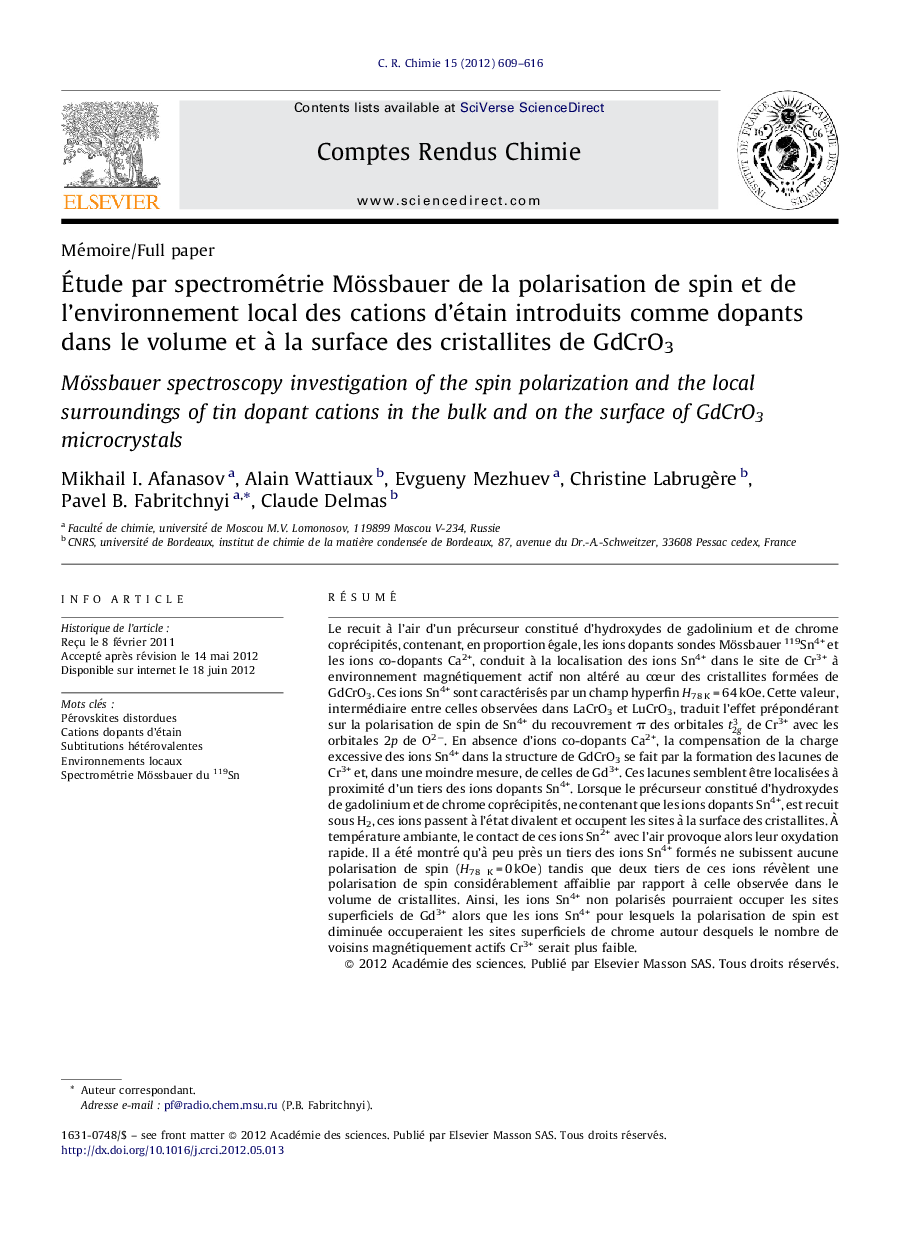| کد مقاله | کد نشریه | سال انتشار | مقاله انگلیسی | نسخه تمام متن |
|---|---|---|---|---|
| 170701 | 458409 | 2012 | 8 صفحه PDF | دانلود رایگان |

RésuméLe recuit à l’air d’un précurseur constitué d’hydroxydes de gadolinium et de chrome coprécipités, contenant, en proportion égale, les ions dopants sondes Mössbauer 119Sn4+ et les ions co-dopants Ca2+, conduit à la localisation des ions Sn4+ dans le site de Cr3+ à environnement magnétiquement actif non altéré au cœur des cristallites formées de GdCrO3. Ces ions Sn4+ sont caractérisés par un champ hyperfin H78 K = 64 kOe. Cette valeur, intermédiaire entre celles observées dans LaCrO3 et LuCrO3, traduit l’effet prépondérant sur la polarisation de spin de Sn4+ du recouvrement π des orbitales t2g3 de Cr3+ avec les orbitales 2p de O2−. En absence d’ions co-dopants Ca2+, la compensation de la charge excessive des ions Sn4+ dans la structure de GdCrO3 se fait par la formation des lacunes de Cr3+ et, dans une moindre mesure, de celles de Gd3+. Ces lacunes semblent être localisées à proximité d’un tiers des ions dopants Sn4+. Lorsque le précurseur constitué d’hydroxydes de gadolinium et de chrome coprécipités, ne contenant que les ions dopants Sn4+, est recuit sous H2, ces ions passent à l’état divalent et occupent les sites à la surface des cristallites. À température ambiante, le contact de ces ions Sn2+ avec l’air provoque alors leur oxydation rapide. Il a été montré qu’à peu près un tiers des ions Sn4+ formés ne subissent aucune polarisation de spin (H78 K = 0 kOe) tandis que deux tiers de ces ions révèlent une polarisation de spin considérablement affaiblie par rapport à celle observée dans le volume de cristallites. Ainsi, les ions Sn4+ non polarisés pourraient occuper les sites superficiels de Gd3+ alors que les ions Sn4+ pour lesquels la polarisation de spin est diminuée occuperaient les sites superficiels de chrome autour desquels le nombre de voisins magnétiquement actifs Cr3+ serait plus faible.
Annealing in air of a precursor consisting of coprecipitated gadolinium and chromium hydroxides, containing, in equal proportion, 119Sn4+ Mössbauer dopant cations and Ca2+ co-dopant cations, leads to the location of Sn4+ ions, in the bulk of the formed GdCrO3 crystallites, on the Cr3+ site with the unaltered magnetically active surrounding. These Sn4+ ions are characterized by hyperfine field H78 K equal to 64 kOe. This value, intermediate between those observed in LaCrO3 and LuCrO3, shows that the spin polarization of Sn4+ originates mainly from a π-type overlap of Cr3+t2g3 -orbitals with O2− 2p-orbitals. In the absence of Ca2+ co-dopant cations, the compensation of the excess charge of Sn4+ in the structure of GdCrO3 involves the formation of Cr3+ vacancies and, to a lesser extent, of Gd3+ vacancies. The vacancies of both types appear to be located in the vicinity of one-third of the Sn4+ dopant ions. In hydrogen atmosphere, annealing the precursor, containing only Sn4+ dopant ions, leads to reduction of Sn4+ ions to the divalent state with concomitant location of the dopant on surface sites of crystallites. Upon contact with ambient air, these Sn2+ ions are rapidly oxidized. Approximatively one-third of the formed Sn4+ exhibit no spin polarization (H78 K = 0 kOe) while two-thirds of them reveal considerable weakening in spin polarization as compared to that in the bulk of crystallites. The non-polarized Sn4+ ions are assigned to Gd surface sites and the weakly polarized Sn4+ ions to Cr surface sites with a reduced number of magnetically active Cr3+ neighboring cations.
Journal: Comptes Rendus Chimie - Volume 15, Issue 7, July 2012, Pages 609–616